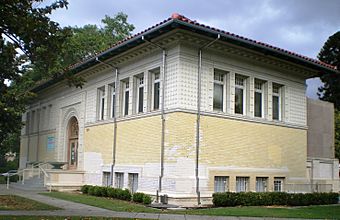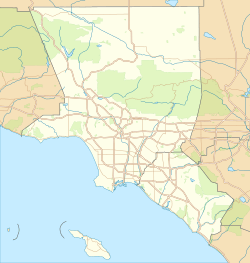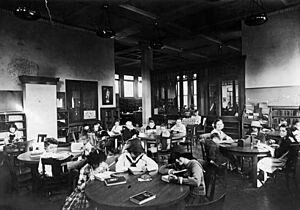Vermont Square Branch Library facts for kids
|
Vermont Square Branch
|
|

Vermont Square Branch, May 2008
|
|
| Location | 1201 W. 48th Street, Los Angeles, California |
|---|---|
| Built | 1913 |
| Architect | Sumner Hunt Silas Reese Burns |
| Architectural style | Italian Renaissance Revival, Mediterranean Revival |
| MPS | Los Angeles Branch Library System TR |
| NRHP reference No. | 87001022 |
Quick facts for kids Significant dates |
|
| Added to NRHP | May 7, 1987 |
The Vermont Square Branch Library is a very special building in Los Angeles, California. It is the oldest branch library in the entire Los Angeles Public Library system! This library was built in 1913. It received money from a famous businessman named Andrew Carnegie. He helped build many libraries across the country.
The Vermont Square Library is one of only three "Carnegie libraries" left in Los Angeles. Because it is so old and important, it has been named a Historic-Cultural Monument. It is also listed on the National Register of Historic Places. This means it is a building with a lot of history that should be protected.
Contents
A Look at the Library's Design
The Vermont Square Branch Library was named a Historic-Cultural Monument in 1983. It was recognized as the oldest library building still standing in Los Angeles. In 1987, it was added to the National Register of Historic Places. This list includes important buildings across the United States.
The library was designed in a style called "Italian Renaissance Revival" and "Mediterranean Revival." These styles often use features like red tile roofs and arched windows. The building has a strong, balanced look. It has a red tile roof with wide eaves, which are the parts that hang over the walls. The front of the building is divided into three parts. The middle part sticks out a little. It has special terra cotta blocks with cool patterns. The main entrance is up a set of stairs. The building also has cream-colored bricks and tall, narrow windows.
A Journey Through Time: The Library's History
Opening Its Doors in 1913
The Vermont Square Branch Library first opened its doors in March 1913. It was the very first library building ever built by the City of Los Angeles. This library was also the first of six branches built with a large gift of $210,000 from Andrew Carnegie.
When the library opened, it had 2,000 new books ready for people to borrow. But the shelves were huge! They were built to hold 16,000 books. A story from the library's early days describes the exciting opening:
The doors opened at 6:00 PM on March 1, 1913. Hundreds of excited people, including men, women, and children, rushed inside. The crowd was so big that the speakers had to give their speeches from behind the main desk! Everyone was amazed by the new library. It felt like a real luxury compared to the old, gloomy places they used to use. The only small problem was the noise. The chairs had steel tips, and they made a loud sound on the cement floor.
The Los Angeles Times newspaper also wrote about the new building. They called it "artistic" and "handsome." They mentioned its cream-colored bricks and white tiles. The roof was described as a "genuine Spanish type" with red tiles. The building was surrounded by a park with flowers and bushes. It was a beautiful addition to the neighborhood.
Andrew Carnegie paid for a total of six libraries in Los Angeles. Today, only three of these original Carnegie libraries are still standing. They are the Vermont Square, Cahuenga, and Lincoln Heights branches.
Early Years and Community Hub
In 1917, the library received a special gift: a "motion picture projection machine." This was used to show movies! The first movie shown was "The Prince and the Pauper," and the auditorium was completely full.
During World War I, the library became a busy place for the local draft board. This board helped decide who would serve in the war. They used the library's story room for 20 months. Many physical exams were done there. Stenographers, who typed reports, worked in the reading room. The library was one of the most visited places in that part of the city. In one year (1917-1918), there were 368 meetings in the library's auditorium. Someone even joked that Monday mornings were the only time the piano could be tuned!
By 1920, the library was so popular that its shelves and seating were almost full. In 1928, a gas furnace was installed. This meant they no longer needed a coal room. The basement was reorganized to create more usable space.
During World War II, the library was used as an air raid shelter. It also served as a Red Cross casualty center. The draft board used it as a registration center too. From 1949 to 1978, the library was the main office for the library's Central Region.
70th Anniversary Celebration
In 1983, the library celebrated its 70th anniversary! They gave an award to Jack Smith, a writer for the Los Angeles Times. He had visited the library often when he was a boy in the 1920s. In his newspaper column, Smith wrote about how he learned to write and think at those "low round tables in the children's room." He also noted that even though the neighborhood had changed, the library remained a peaceful "oasis."
The grandsons of the person who donated the land for Vermont Square Park also wrote a letter to the Los Angeles Times. They shared how important the library was to their own childhoods. They wrote about how books from the library let them imagine adventures, battles, and explorations.
Renovation and Reopening in the 1990s
The library had to close in May 1990. This was because its walls were not strong enough to meet new safety rules for earthquakes. The building went through a big renovation. It reopened in May 1996, looking much better and safer.
As part of the renovation, new artwork was added by an artist named Nobuho Nagasawa. Her art includes useful library furniture. For example, there are 11 small stools for preschoolers. Each stool is shaped like a letter, and together they spell out the word "IMAGINATION." There is also a glass table with the names of books sandblasted onto it. These are books that have been banned in some schools in America.






